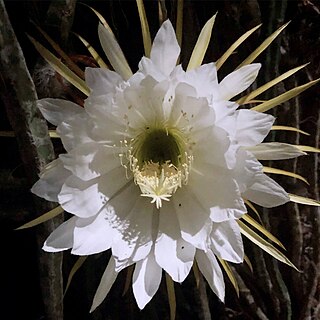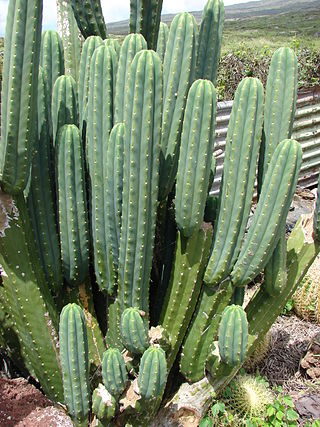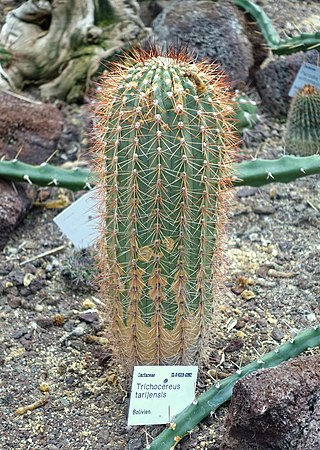San Pedro is the Spanish language form of Saint Peter. It can refer to:

Night-blooming cereus is the common name referring to a large number of flowering ceroid cacti that bloom at night. The flowers are short lived, and some of these species, such as Selenicereus grandiflorus, bloom only once a year, for a single night, though most put out multiple flowers over a period of several weeks, each of which opens for only a single night. Other names for one or more cacti with this habit are princess of the night, Honolulu queen, Christ in the manger, dama de noche, and queen of the night.

Echinopsis is a large genus of cacti native to South America, sometimes known as hedgehog cactus, sea-urchin cactus or Easter lily cactus. One small species, E. chamaecereus, is known as the peanut cactus. The 128 species range from large and treelike types to small globose cacti. The name derives from echinos hedgehog or sea urchin, and opsis appearance, a reference to these plants' dense coverings of spines.

In 1984, the International Organization for Succulent Plant Study set up a working party, now called the International Cactaceae Systematics Group, to produce a consensus classification of the cactus family, down to the level of genus. Their classification has been used as the basis for systems published since the mid-1990s. Treatments in the 21st century have generally divided the family into around 125–130 genera and 1,400–1,500 species, which are then arranged in a number of tribes and subfamilies. However, subsequent molecular phylogenetic studies have shown that a very high proportion of the higher taxa are not monophyletic, i.e. they do not contain all of the descendants of a common ancestor. As of August 2023, the internal classification of the family Cactaceae remained uncertain and subject to change. A classification incorporating many of the insights from the molecular studies was produced by Nyffeler and Eggli in 2010.

Neoraimondia is a genus of medium to large cacti from Peru. The genus is named after the Italian-born Peruvian explorer, naturalist, and scientist, Antonio Raimondi.

The term ceroid cactus is used to describe any of the species of cacti with very elongated bodies, including columnar growth cacti and epiphytic cacti. The name is from the Latin cēreus, wax taper, referring to the stiff, upright form of the columnar species. Some species of ceroid cacti were known as torch cactus or torch-thistle, supposedly due to their use as torches by Native Americans in the past.

Echinopsis lageniformis, the Bolivian torch cactus, is a fast-growing columnar cactus from the high deserts of Bolivia. Among the indigenous populations of Bolivia, it is sometimes called achuma or wachuma, although these names are also applied to related species such as Echinopsis macrogonus which are also used for their psychedelic effects.

Echinopsis scopulicola is a type of cactus native to Bolivia, which contains psychedelic compounds. Many claimed this species contained mescaline. This was confirmed in 2010 in a study of well-documented individual living plants of the subgenus Trichocereus of the genus Echinopsis. E. scopulicola was noted to contain 0.82% mescaline by dry weight in the outer green layer.

Soehrensia spachiana, commonly known as the golden torch, (white) torch cactus or golden column, is a species of cactus native to South America. Previously known as Trichocereus spachianus for many years, it is commonly cultivated as a pot or rockery plant worldwide. It has a columnar habit, with a lime-green cylindrical body with 1–2 cm long golden spines.

3,4-Dimethoxyphenethylamine (DMPEA) is a chemical compound of the phenethylamine class. It is an analogue of the major human neurotransmitter dopamine where the 3- and 4-position hydroxy groups have been replaced with methoxy groups. It is also closely related to mescaline which is 3,4,5-trimethoxyphenethylamine.

Trichocereus macrogonus, synonym Echinopsis macrogonus, is a species of cactus found in Ecuador, Peru and Bolivia. Two varieties are accepted as of September 2023: var. macrogonus and var. pachanoi. Plants contain varying amounts of the psychoactive alkaloid mescaline. They have been used both ritually and intraditional medicine from pre-Columbian times. Trichocereus macrogonus is one of a number of similar species that may be called San Pedro cactus. Indigenous names include achuma and huachuma, although these may be applied to similar species.

Trichocereus macrogonus var. pachanoi is a fast-growing columnar cactus found in the Andes at 2,000–3,000 m (6,600–9,800 ft) in altitude. It is one of a number of kinds of cacti known as San Pedro cactus. It is native to Ecuador and Peru, but also found in Argentina, Bolivia, Colombia, Chile and Venezuela and cultivated in other parts of the world. Uses for it include traditional medicine and traditional veterinary medicine, and it is widely grown as an ornamental cactus. It has been used for healing and religious divination in the Andes Mountains region for over 3,000 years.

Cimora is a Peruvian term used to describe a brew with hallucinogenic properties made from the “San Pedro” cacti and other plants such as chamico in South America, used traditionally for shamanic purposes and healing in Peru and Bolivia. The name is also used to describe a number of both hallucinogenic and non-hallucinogenic plants in the region, some of which are used in traditional medicines. Which plants go by the name cimora is an ethnobotanical problem that has been debated at great length by ethnobotanists in many different journals. The term cimora is said to refer to algo malo, meaning something bad. San Pedro goes by many names including pachanoi, aguacolla, elremedio, gigantón, and cactus of the four winds. The ritualistic use of the brew is similar to ayahuasca, which is a South American used as a traditional spirit medicine in Brazil, although while the active ingredient in ayahuasca is DMT, the active ingredient in cimora is mescaline. The use of cimora and the rituals involved have evolved throughout history due to the influence of those who controlled Peru at different stages, although it has almost always involved the use of the San Pedro cactus and its mescaline content.
Many cacti are known to be psychoactive, containing phenethylamine alkaloids such as mescaline. However, the two main ritualistic (folkloric) genera are Echinopsis, of which the most psychoactive species occur in the San Pedro cactus group, and Lophophora, with peyote being the most psychoactive species. Several other species pertaining to other genera are also psychoactive, though not always used with a ritualistic intent.

Leucostele terscheckii, commonly known as the cardon grande cactus or Argentine saguaro, is a large cactus native to South America and popular in cultivation.

Echinopsis strigosa, is a species of Soehrensia in the cactus family. It is native to north western Argentina. It was first published in Cactaceae Syst. Init. 28: 31 in 2012.

Soehrensia tarijensis, is a species of Soehrensia, in the cactus family. It is native to Bolivia and northwestern Argentina.

Lobivia arachnacantha is a species of cactus in the genus Lobivia, native to Bolivia. As its synonym Echinopsis arachnacantha it has gained the Royal Horticultural Society's Award of Garden Merit.

The stela of the cactus bearer is a monolith or stele of a single piece of granite, belonging to the Chavín culture of ancient Peru, which remains in its original location on the northwest side of the circular plaza at the archaeological site known as the ceremonial center of Chavín de Huántar in the Ancash region of Peru. It was discovered during the 1972 excavation season by Peruvian archaeologist Luis Guillermo Lumbreras.

Leucostele deserticola is a species of cactus native to South America

















